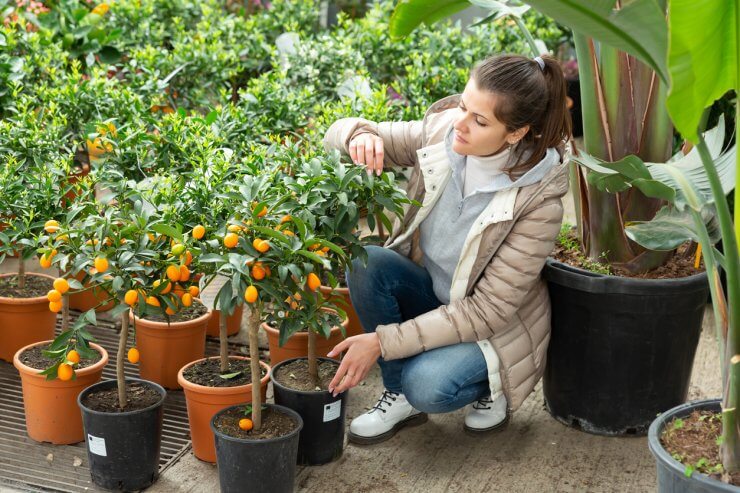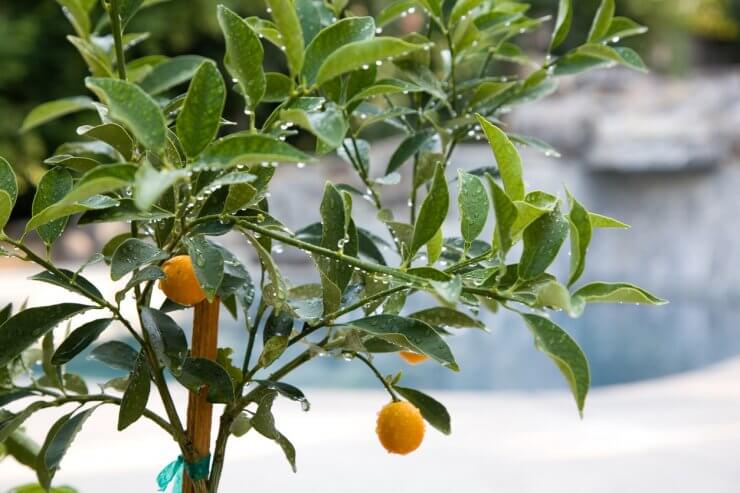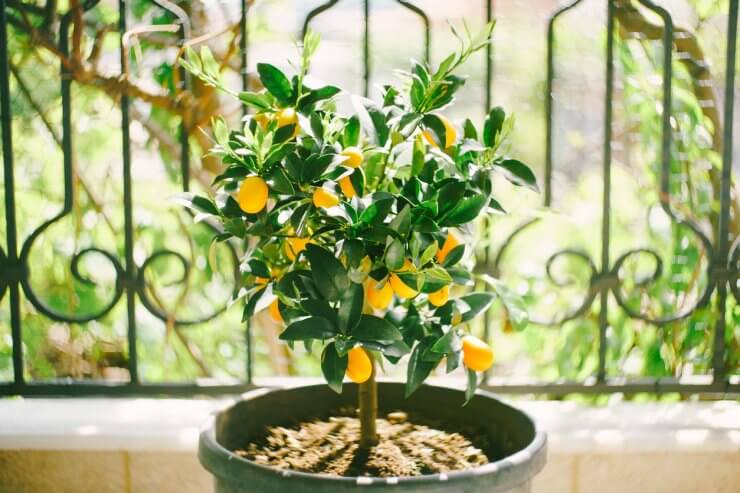
Potted kumquat trees can be a good choice
Kumquats are easy to plant and grow, and they have fairly simple growing requirements: a sunny spot and good soil drainage. They are pretty flexible when it comes to soil: they’re not picky about pH, but they demand good drainage. Soggy roots lead to root rot which can lead to losing your tree.
If you have a large outside plot of land with the right soil and the right conditions for watering and draining—and you’re in the target outdoor zone—you might have the ideal situation for planting your kumquat trees directly in the ground. If, however, you live in a zone that’s not 9 or 10, container gardening may be your best bet.
Kumquat Welcome Kit

Young kumquat tree with a support stake
No matter where you decide to plant it, getting a tree is no small project. Make sure you are prepared for the tree before it arrives at your door. Have the ground (or container) prepared, and have some essential supplies on hand.
- Support stakes for young saplings to keep them upright as they acclimate to their new growing space
- Masking tape to use as a physical barrier between the ground and crawling insects that may be attracted to your tree; wrapped separately around the tree trunk and support stake, usually used in conjunction with…
- Tangle Guard and Tanglefoot to deter or catch pests (such as aphids and ants) that can infest a young tree (see What to Do About Pests for details on putting these pest fighters into action)
Growing Kumquats in Raised Beds

Kumquat tree with fruit
Raised beds are an option for growing kumquats if you have perpetually wet, heavy soil. However, you’ll want to get trees in the semi-dwarf category; otherwise, harvesting your kumquats will become more of challenge with each year that passes. If you do go that route, know that creating raised beds can be a lot of work the first time you set up your beds, but having raised beds allows you more control over your growing environment and it’s definitely a good way to ensure your roots don’t get bogged down.
To create nicely contained raised beds for your kumquat trees, enclose your raised beds with wooden sides 12 to 18 inches deep, or even a bit deeper—this will give the plants’ roots room for spreading.
A raised bed garden is less likely to contain the seeds of weeds that are often found in garden soil. You’ll minimize the incidence of weeds overall, which will save you time and effort later. Weeding itself is much easier with raised beds, because you don’t have to get down so far on the ground to remove weeds.
Raised Bed Planting Tip: Be sure to amend your soil with compost at least once a year. Otherwise, your soil can become less productive for your plants.
Growing Kumquats in Containers or Pots

Kumquat tree in container
If you don’t have the space for growing in open land or in raised beds—let’s say you live in an apartment with no land of your own for a garden—you can grow kumquat trees in containers or pots on your balcony, porch, patio, or deck.
One great advantage to container gardening is the ability to move plants around more easily to maximize their exposure to the sun. Kumquats need six to eight hours of sun a day to fully fruit.
Tip: If you have trouble moving pots around, because they’re too heavy or too bulky, try putting your pots on slightly raised rolling casters so you can more easily move them around your space.
Kumquat trees can flourish in a container. But keep in mind that kumquats will fail to thrive if they’re root-bound. Make sure you plant your trees in a very large container. Half barrels or 5-gallon tubs work well. It’s a good idea to add some drainage holes to your container, and be sure to keep the container elevated to ensure good drainage and air circulation. Fill the containers with potting mix, not ground soil. Don’t use fertilizer for the first two to three months after you’ve potted your tree, and use a fertilizer specifically developed for citrus trees.
Though weeding is much easier with containers, you have to be more vigilant about watering and irrigation as your tree can dry out much faster than when it’s in the ground—but overwatering your kumquats can cause root rot. Plus, containers can lose important soil nutrients throughout the season, so you might need additional fertilizer.
Kumquat trees are cold-hardy, but don’t put your tree at risk. Trees in containers will get colder faster. Bring your trees inside when the weather turns cold to protect your tree from roots to tip.
How do you grow your kumquats—in open land, in raised beds, or in containers? Why do you prefer your method? Please tell us your tips and tricks for nurturing kumquat trees.


 Previous
Previous


I wish I had read your articles on taking care of Kumquat trees a couple of years ago.
We enjoyed the 90+ kumquats but the tree died shortly thereafter.
Obviously, I didn’t know to take care of the tree: prune, feed, take care of over-crowded roots, etc.
Thank you for an excellent read!!!